Analysis of the Influence of Structure and Parameters of Axial Piston Pump on Flow Pulsation
Abstract
:1. Introduction
2. Working Principle, Kinematics, and Output Flow Analysis of Swashplate Axial Piston Pump
2.1. Working Principle and Kinematics Analysis of Swashplate Axial Piston Pump
2.2. Output Flow Analysis of Swashplate Axial Piston Pump under Variable Operating Conditions
2.2.1. Theoretical Analysis of Flow Pulsation in Odd-Numbered Piston Pump
2.2.2. Theoretical Analysis of Flow Pulsation of Even-Numbered Piston Pump
3. Analysis of the Influence of the Parameters of the Plunger Piston on the Output Flow
3.1. Analysis of the Influence of Swashplate Angle on Output Flow of Piston Pump
3.2. Analysis of the Influence of the Prime Mover Speed on the Output Flow of the Plunger Pump
3.3. Analysis of Influence of Piston Diameter on Output Flow of Piston Pump
3.4. Analysis of the Influence of Port Plate Structure on the Output Flow of Piston Pump
4. Experimental Verification
5. Conclusions
- (1)
- Through the above analysis, it can be seen that the speed of the prime mover, swashplate angle, diameter of the piston, and port plate structure of the piston pump have an important impact on the flow pulsation of the piston pump. In the actual work of the piston pump, in order to effectively reduce the flow pulsation of the plunger pump and reduce the noise caused by the flow pulsation, the port plate structure should be optimized. That is, the pre-compression angle and misalignment angle of the piston pump should be appropriately reduced, and the inclination of the swashplate and the rotation speed of the prime mover should be controlled within a certain range. When the swashplate angle is 5–10°, the output flow can quickly reach a stable state; when the speed of the prime mover is 1100–1300 r/min, the output flow of the plunger pump can quickly reach a stable state.
- (2)
- In order to reduce the flow pulsation and facilitate the processing and manufacturing in the project, for the odd-numbered piston pump, the pre-compression angle and misalignment angle should be = = 1°; for the even-numbered piston pump, the dead angle and staggered supporting role of the port plate should be = = 3°. At present, the nine-piston piston pump is commonly used in the project, but when the dead angle and staggered supporting role of the port plate are set at = =1°, the pulse rate of the nine-piston piston pump is very close to that of the ten-piston piston pump, which provides a theoretical basis for the popularization and application of the ten-piston piston pump.
- (3)
- The error rate between the model and the experimental data is low, and the model is in positive agreement with the experimental data. The correctness of the simulation model is verified through experiments, which provides a basis for the design and improvement of the piston pump.
Author Contributions
Funding
Acknowledgments
Conflicts of Interest
References
- Qian, W.X.; Gao, Q.H.; Li, X.Y.; Zhang, Y. Simulation Research on Flow Pulsation Characteristics of Axial Piston Pump Based on AMESim. Mach. Tool Hydraul. 2018, 46, 114–117. [Google Scholar]
- Qian, W.; Gao, Q.; Li, X.; Li, Y. Co-simulation Research on Flow Pulsation Characteristics of Plunger Pump Based on AMESim and ADAMS. In Proceedings of the 2017 5th International Conference on Mechatronics, Materials, Chemistry and Computer Engineering (ICMMCCE 2017), Chongqing, China, 15–16 December 2017. [Google Scholar]
- Xu, Z.Y.; Miao, X.H.; Zuo, H. The research on pulsation of pump pressure in water mist system. Energy Procedia 2015, 66, 73–76. [Google Scholar]
- Liu, Y.; Jiang, W.; Bao, C.W. Simulation Analysis of Flow and Pressure of Swashplate Axial Piston Pump Based on AMESim. Sci.-Tech. Innov. Product. 2019, 11, 50–53. [Google Scholar]
- Gao, L. Finite Element Analysis and Flow Pulsation of Key Components of Piston Pump. Master’s Thesis, Hebei University of Engineering, Handan, China, 2022. [Google Scholar]
- Zhang, H. Cavitation effect to the hydraulic piston pump flow pulsation. Appl. Mech. Mater. 2014, 599, 230–236. [Google Scholar] [CrossRef]
- Kojima, E.; Nagakura, H. Characteristics of Fluidborne Noise generated by Fluid Power Pumps: 1st Report, Mechanism of Generation of Pressure Pulsation in Axial Piston Pump. JSME Int. J. 2008, 25, 46–53. [Google Scholar] [CrossRef] [Green Version]
- Andreev, M.; Grätz, U.; Lamparter, A. Pipeline Simulation by the Method of Characteristics for Calculating the Pressure Pulsation of a High-Pressure Water Plunger Pump. publications.rwth-aachen.de, Aachen, Germany. 2018. Available online: http://publications.rwth-aachen.de/record/726223/files/726223.pdf?version=1 (accessed on 28 September 2022).
- Li, L. Effect of Indexing Valve Plate Angle on Swash Plate Moment and Instantaneous Flow Characteristics of Swash Plate Variable Axial Piston Pump. Master’s Thesis, Lanzhou University of Technology, Lanzhou, China, 2019. [Google Scholar]
- Han, J.L. Analysis of Flow Characteristics of Swashplate Axial Piston Pump. Master’s Thesis, Shandong University, Jinan, China, 2020. [Google Scholar]
- Han, X.; Sun, Z.G.; Yang, M. Flow Pulsation Analysis and Throttle Groove Optimization of Axial Piston Pump Based on FLUENT. Coal Mine Mach. 2021, 42, 24–27. [Google Scholar]
- Li, S.; Wang, G.Z. Research of Ripple in Piston Pump Based on Pre-compression Volume. Mach. Tool Hydraul. 2020, 48, 166–170. [Google Scholar]
- Zhu, H.; Bo, G.; Zhou, Y.B. Pump Selection and Performance Prediction for the Technical Innovation of an Axial-Flow Pump Station. Math. Probl. Eng. 2018, 2018, 1–9. [Google Scholar] [CrossRef]
- Zhang, T.X.; Zhang, N. Vibration Modes and the Dynamic Behaviour of a Hydraulic Plunger Pump. Shock. Vib. 2016, 2016, 1–7. [Google Scholar] [CrossRef] [Green Version]
- Olems, L. Investigations of the temperature behaviour of the piston cylinder assembly in axial piston pumps. Int. J. Fluid Power 2000, 1, 27–39. [Google Scholar] [CrossRef]
- Guo, F.; Gao, Y.Q.; Zheng, W. Influence of the Flux Pulsation on Pressure Pulsation of the Axial Piston Pump and Its Analysis. J. Shandong Univ. Sci. Technol. (Nat. Sci.) 2007, 5, 49–52. [Google Scholar]
- Xu, S.J. Study of Axial Piston Pump’s Pulsant Flux. Mach. Build. Autom. 2007, 3, 39–41+43. [Google Scholar]
- Wang, H.Y.; Wei, X.Y. Simulation Study on the Flow Pulsation Characteristics of Axial Piston Pump. Mach. Tool Hydraul. 2014, 42, 144–148. [Google Scholar]
- Yuan, H. Structural Optimization Design on the Key Parts of Swash Plate Axial Piston Pump. Master’s Thesis, Hefei Polytechnic University, Hefei, Chian, 2014. [Google Scholar]
- Hu, M. Design Investigation of The Swash Plate Axial Piston Pump with Conical Cylinder Blocks. Master’s Thesis, Lanzhou University of Technology, Lanzhou, China, 2011. [Google Scholar]
- Feng, K.; Borghesani, P.; Smith, W.A.; Randall, R.B.; Chin, Z.Y.; Ren, J.Z.; Peng, Z.X. Vibration-based updating of wear prediction for spur gears. Wear 2019, 426–427, 1410–1415. [Google Scholar] [CrossRef]
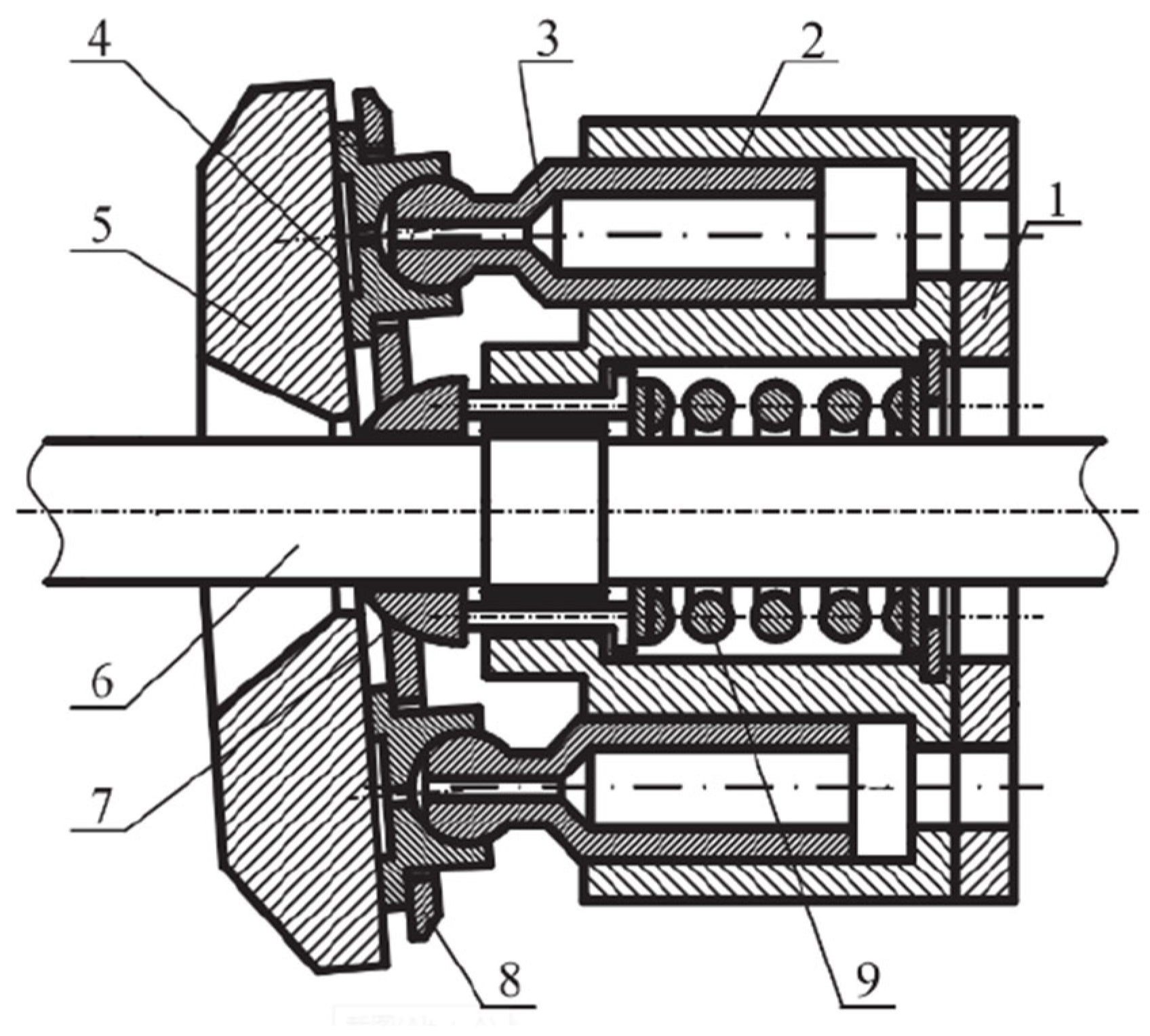
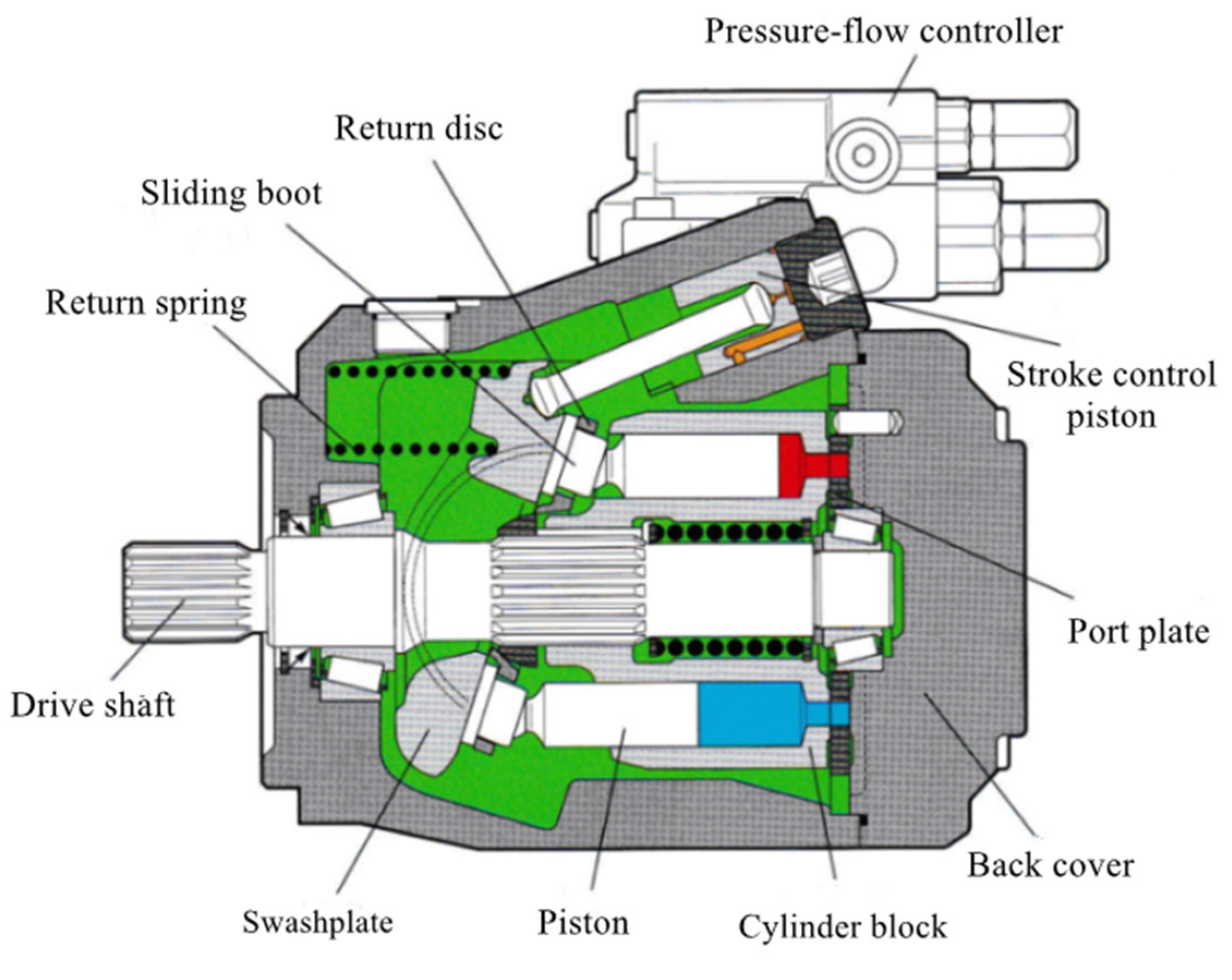
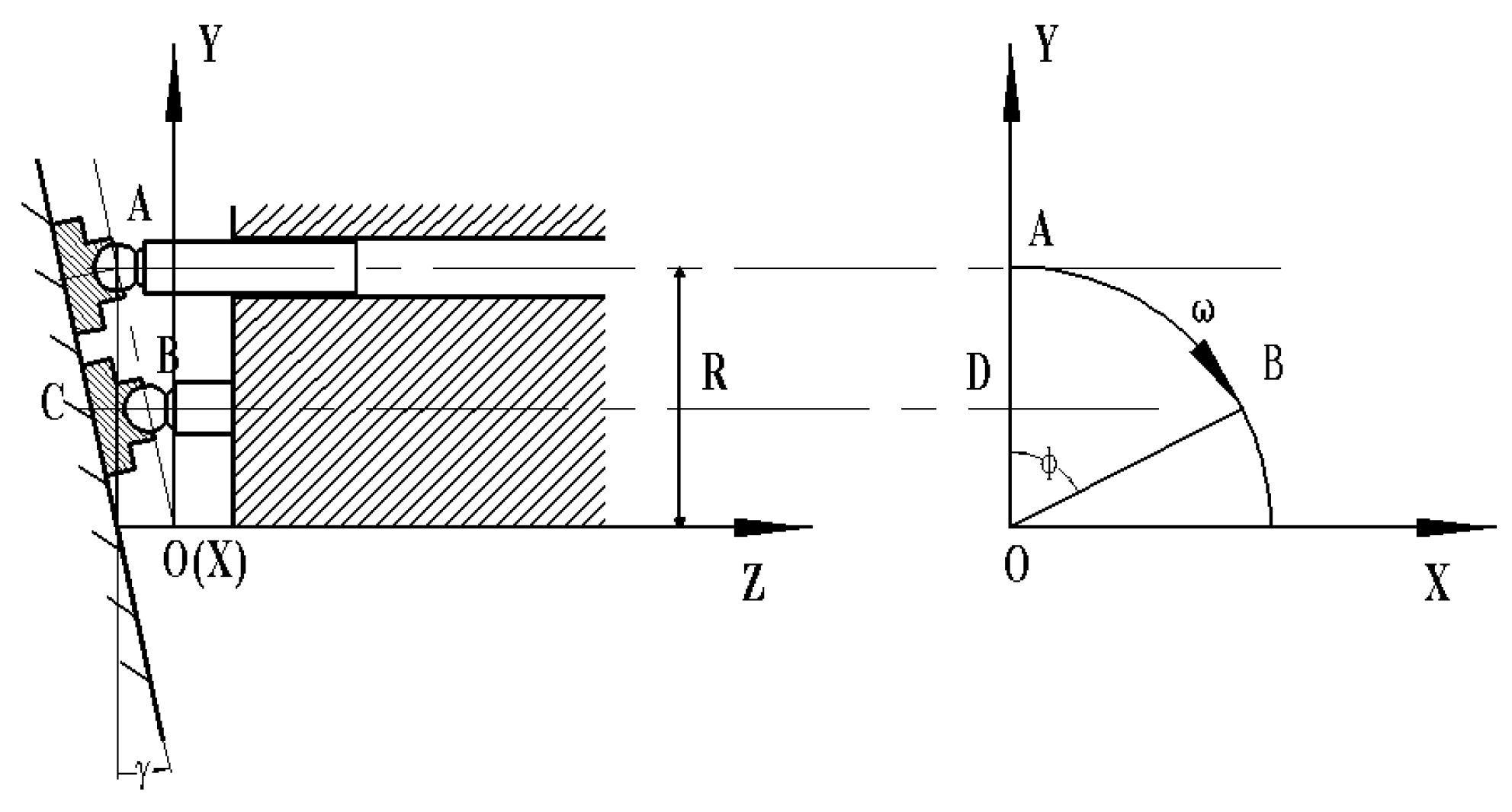

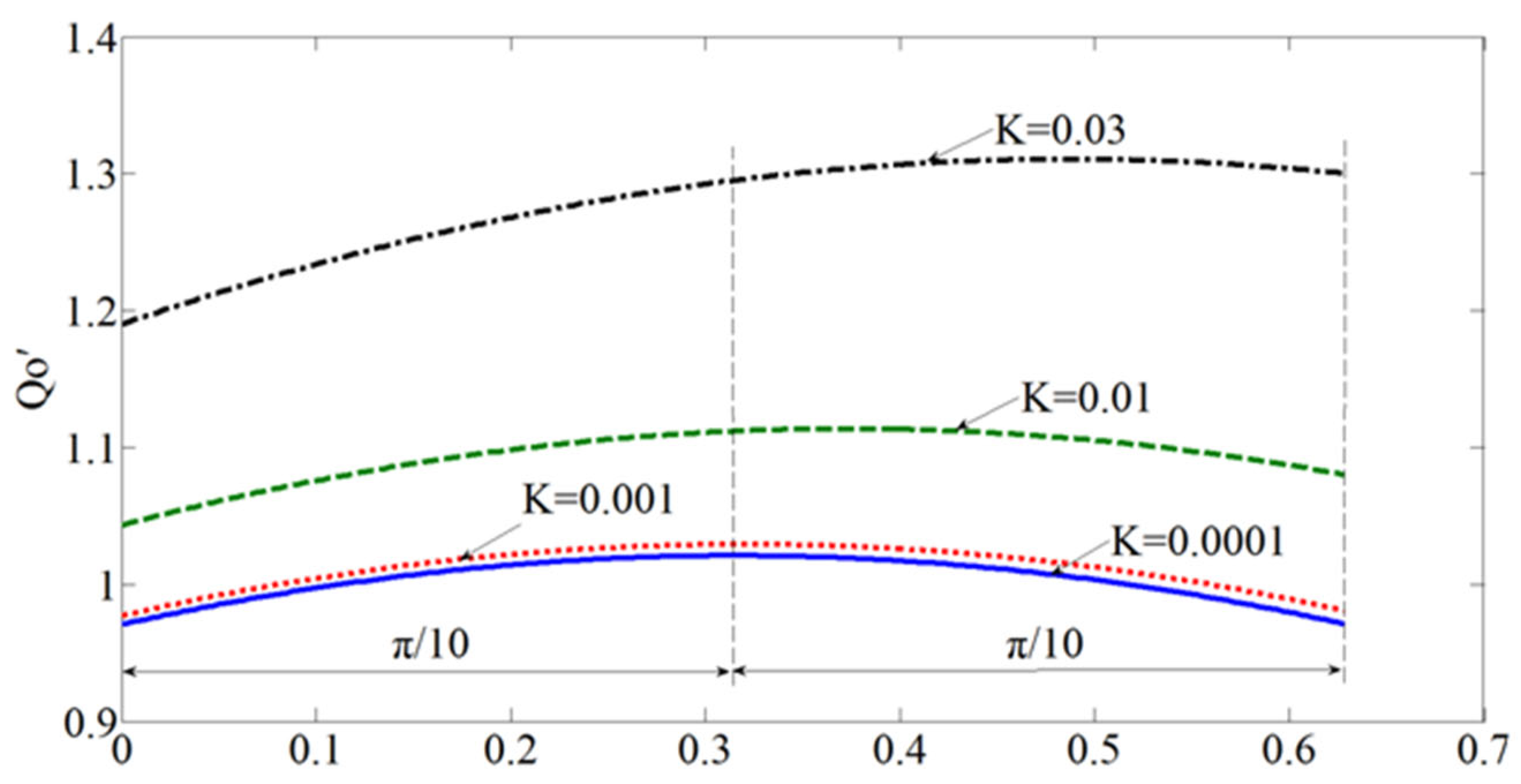




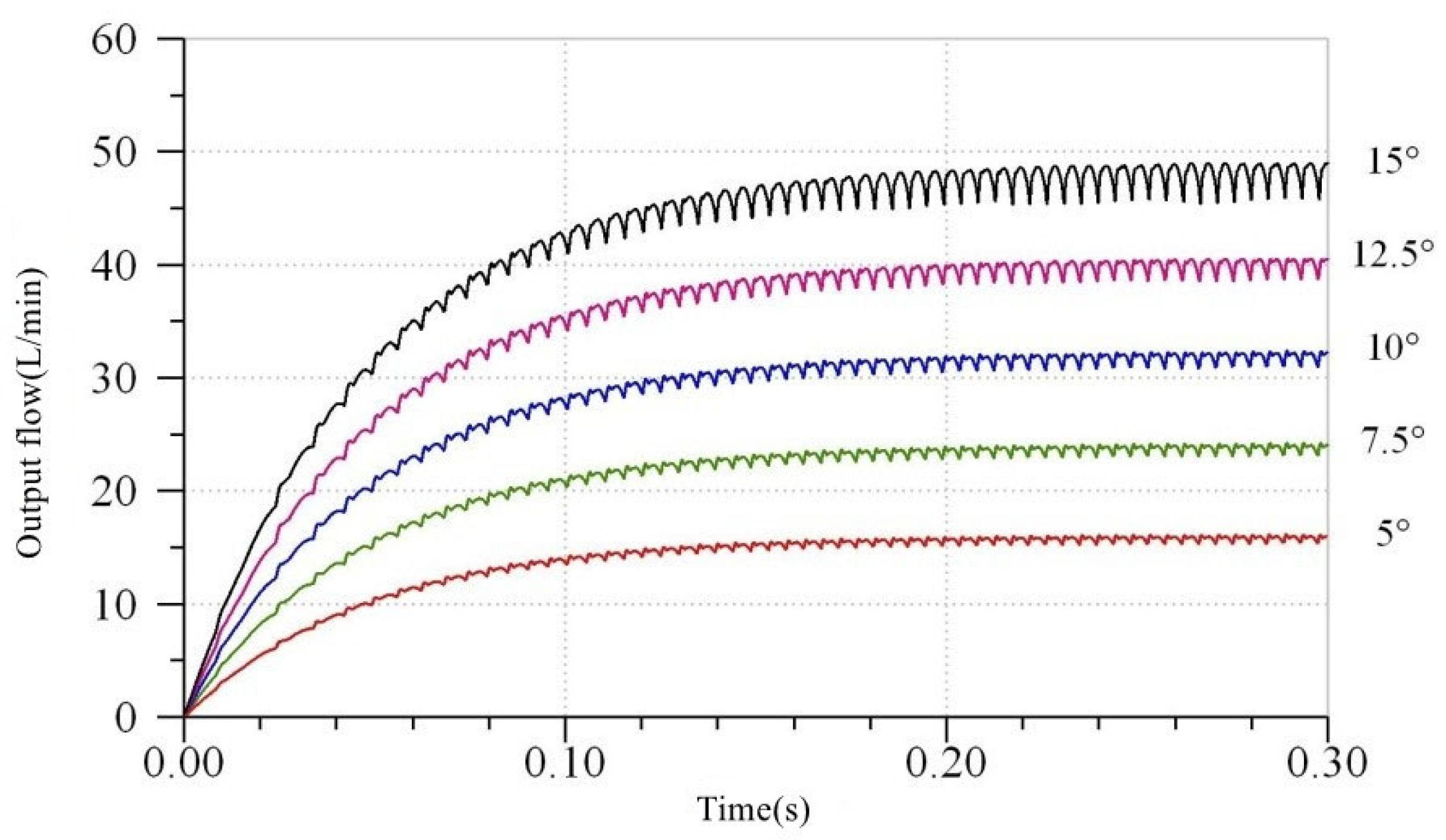




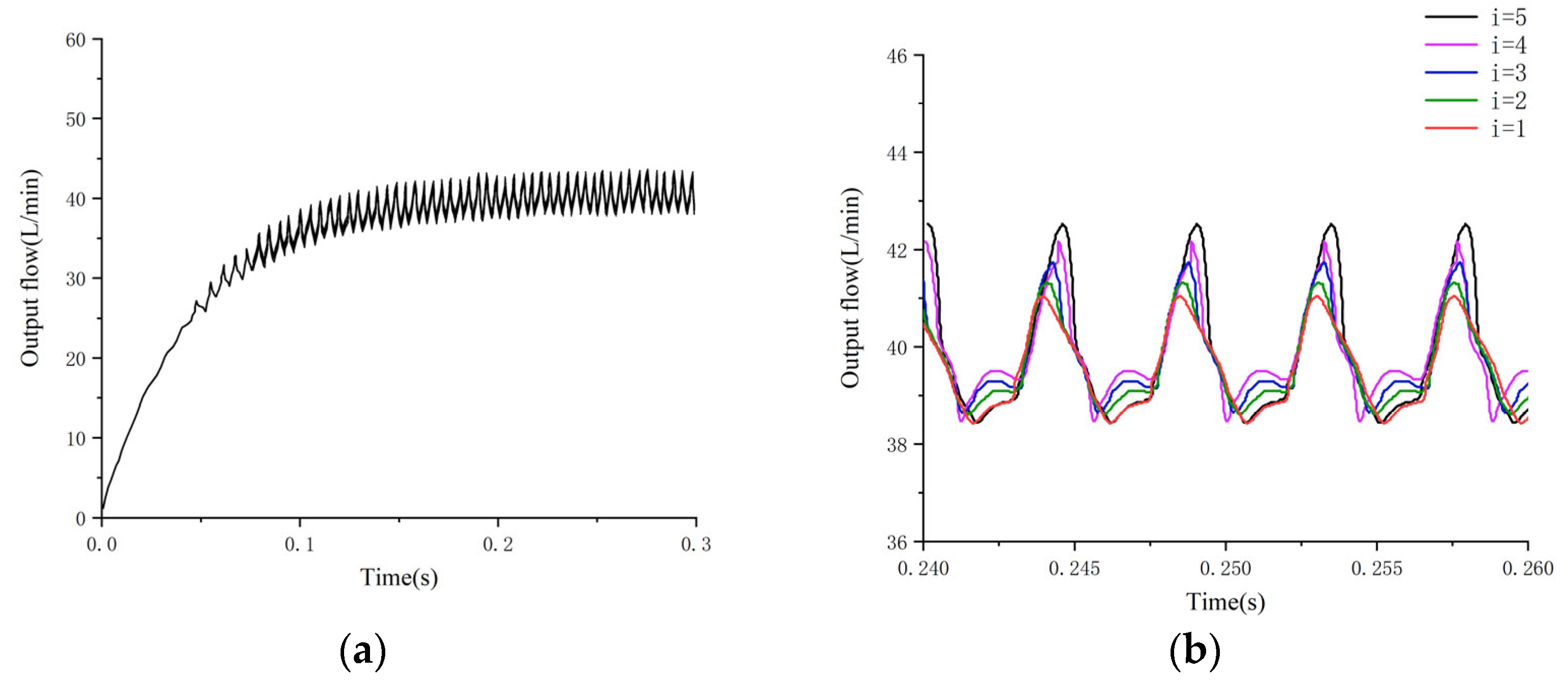
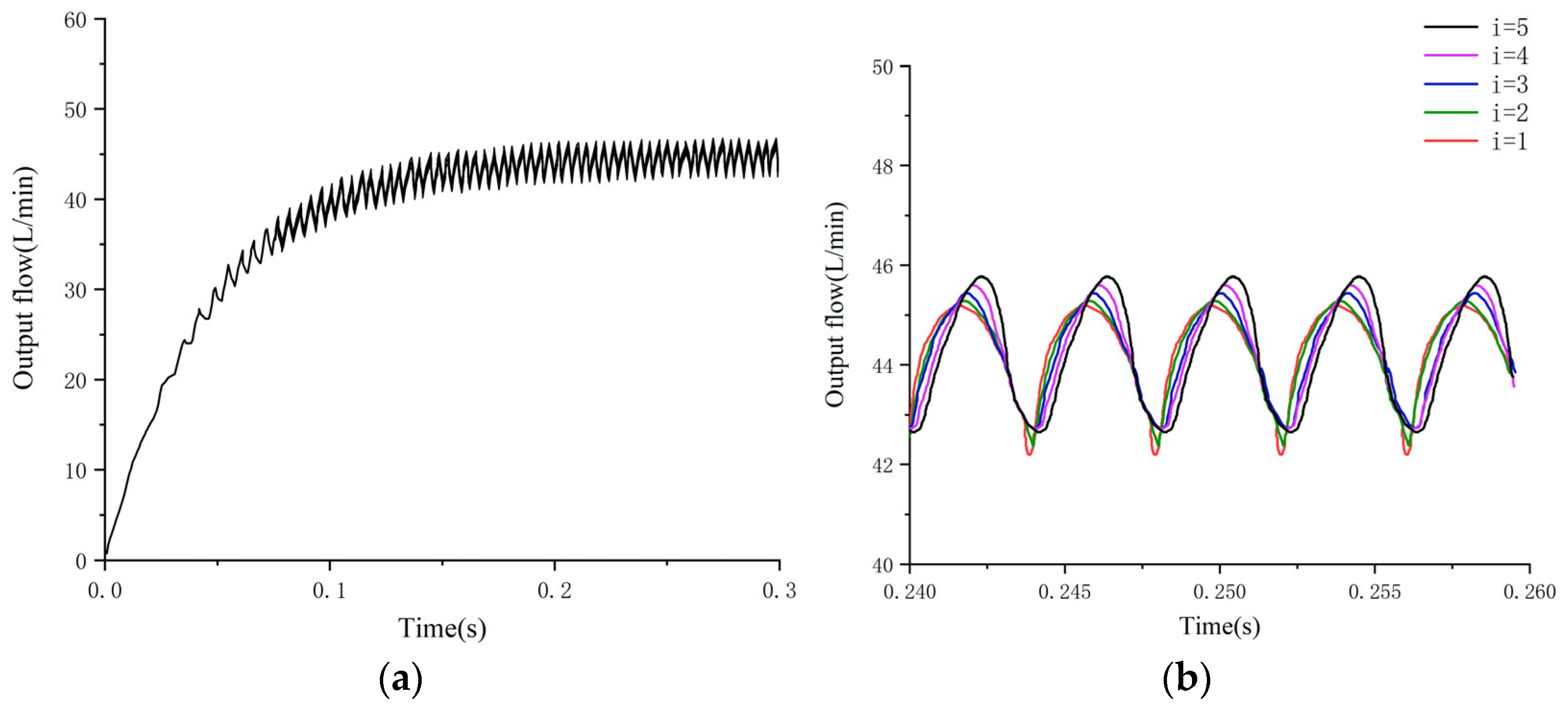
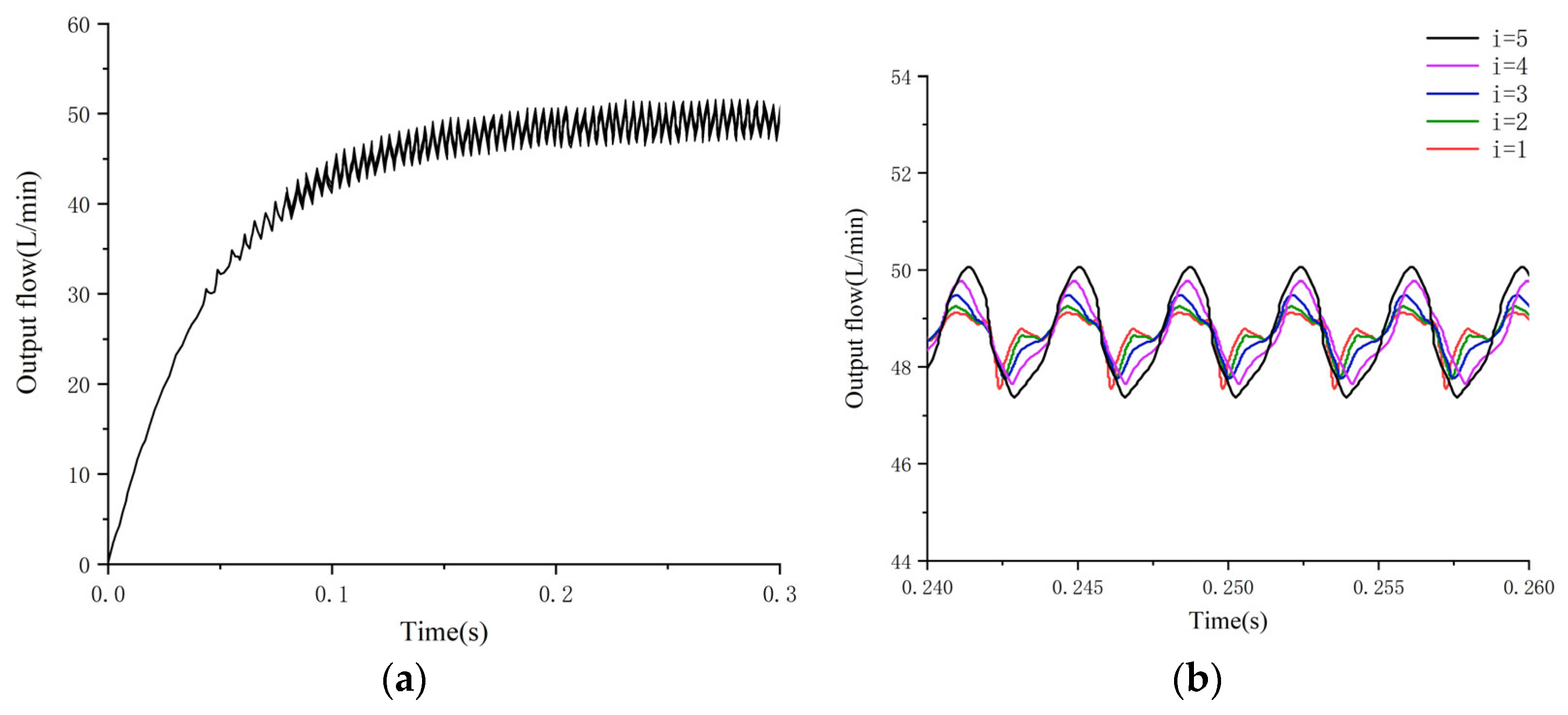
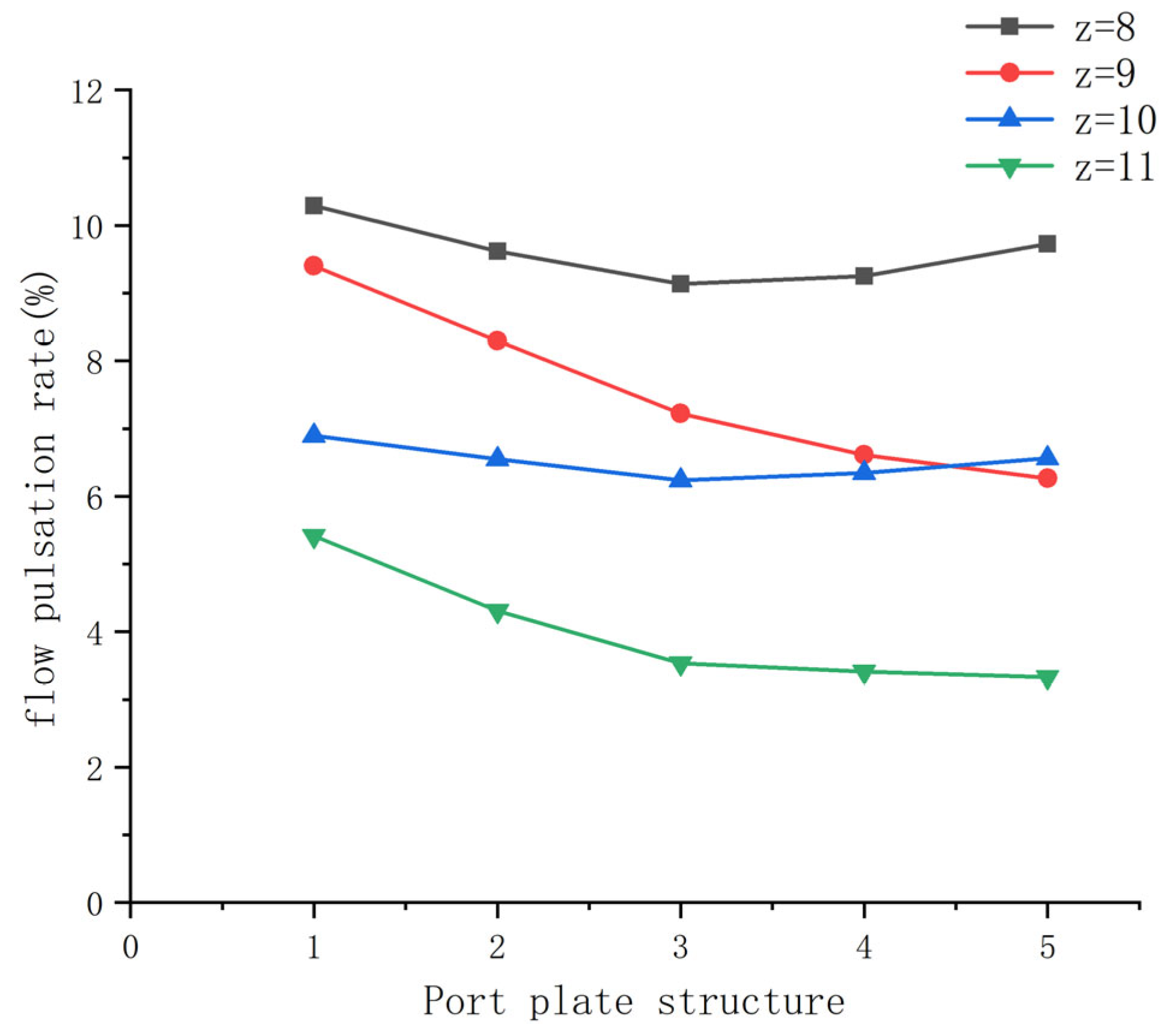
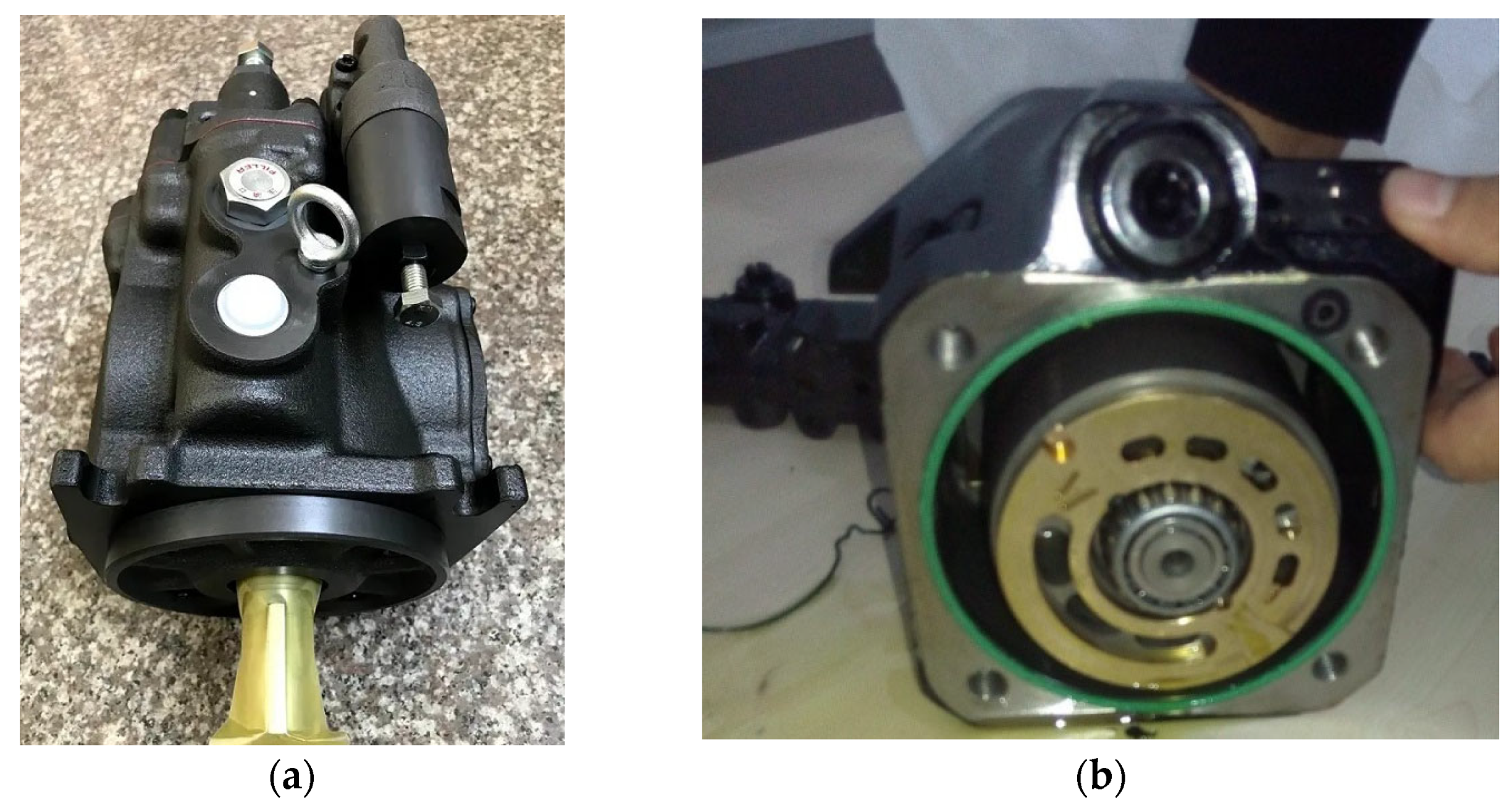
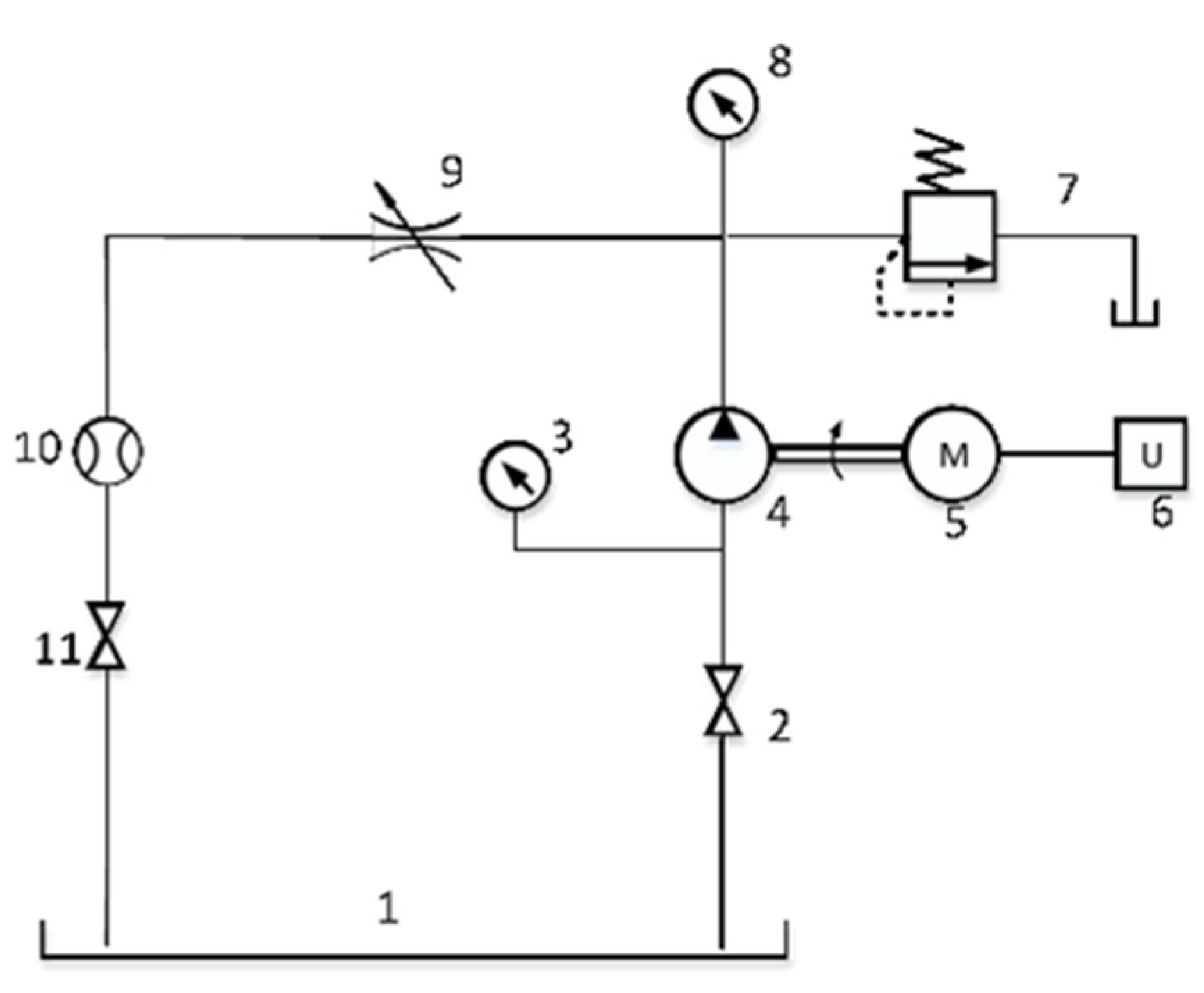
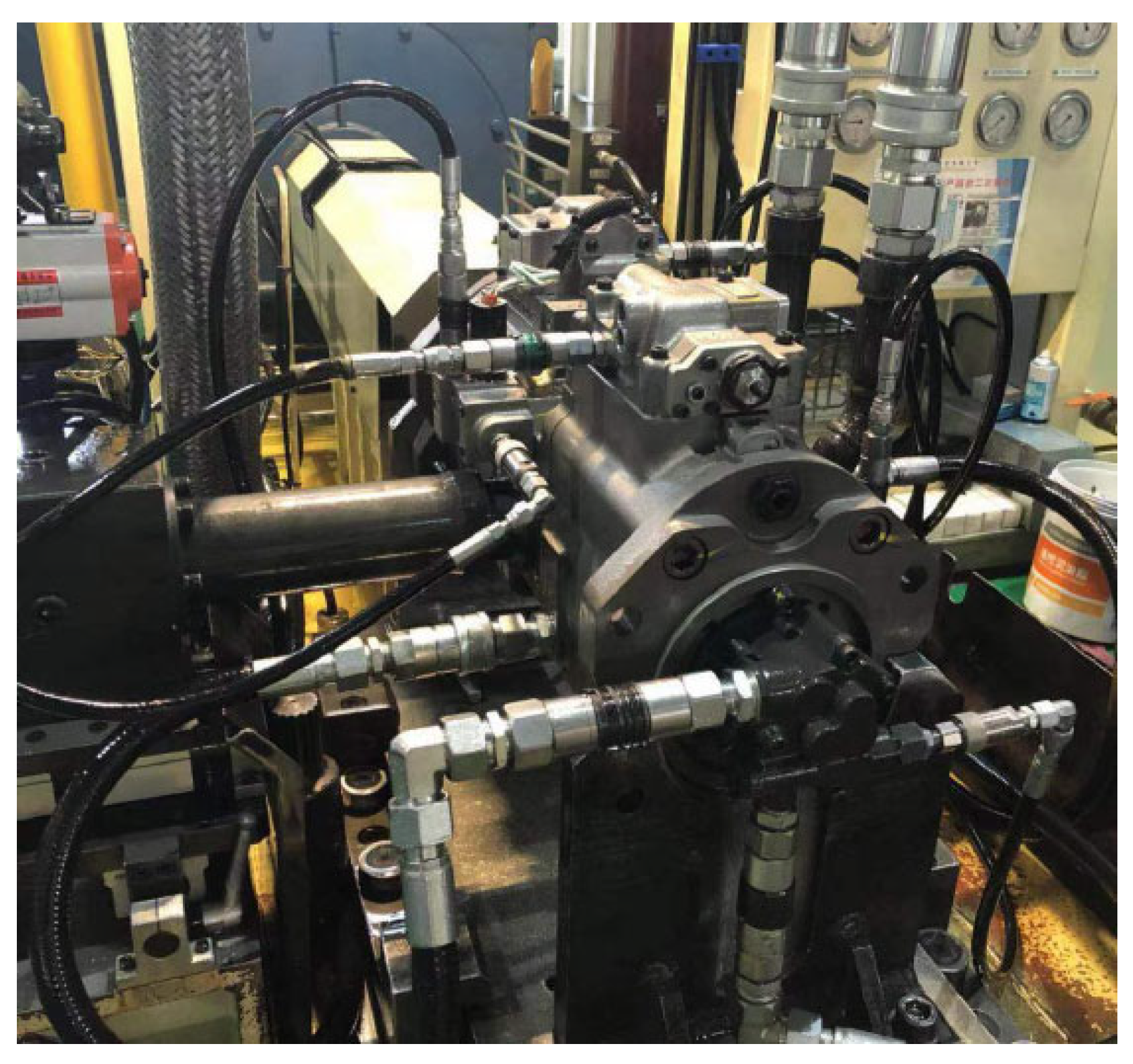

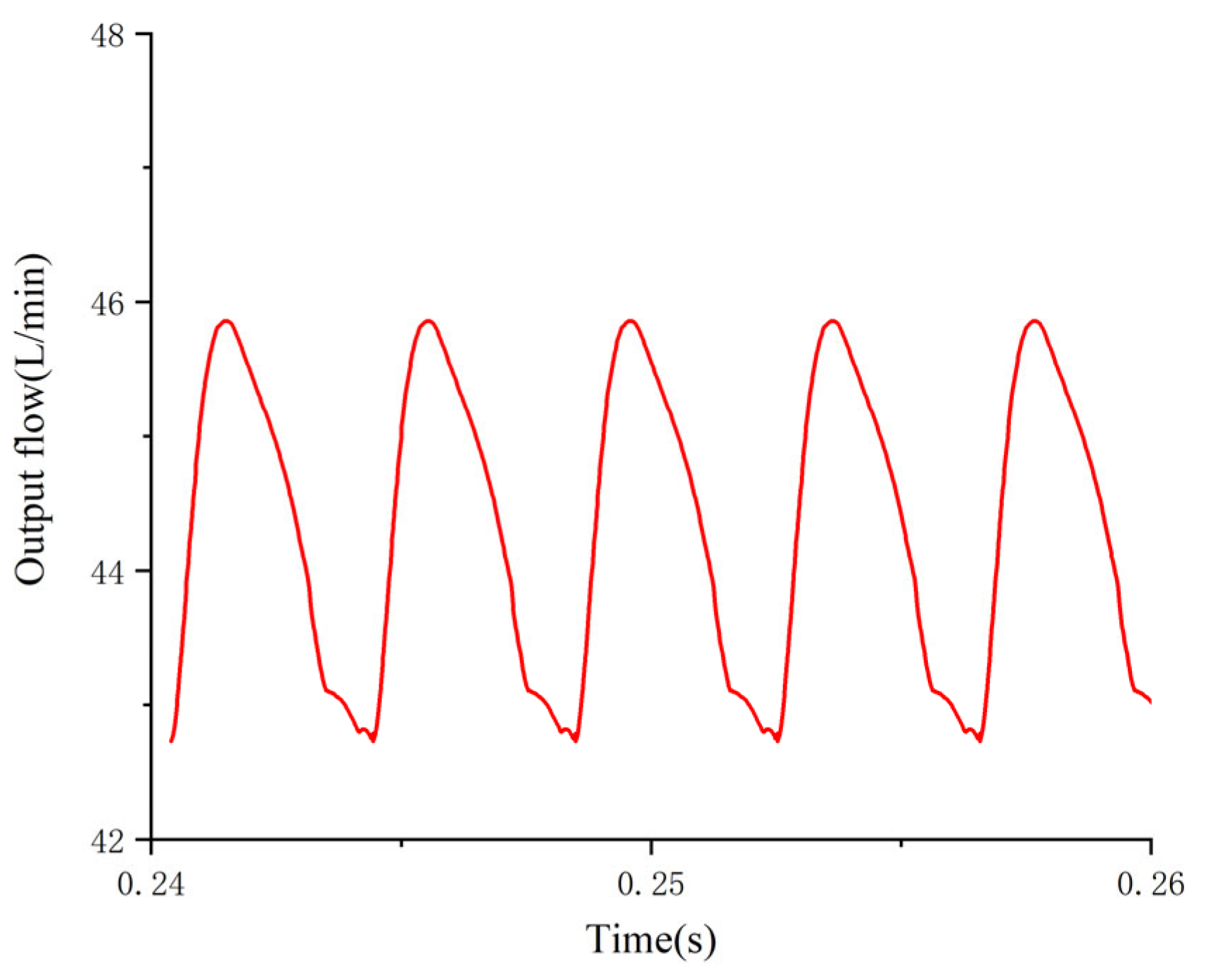
| K (Variable Speed Ratios) | 0.0001 | 0.001 | 0.01 | 0.03 |
|---|---|---|---|---|
| , z = 9) | 1.47 | 1.83 | 4.78 | 11.97 |
| , z = 10) | 5.01 | 5.18 | 7.0 | 12.03 |
| Type i Structure (i = 1–5) | Pre-Compression Angle (°) | Misalignment Angle (°) |
|---|---|---|
| 1 | 10 | 5 |
| 2 | 8 | 4 |
| 3 | 6 | 3 |
| 4 | 4 | 2 |
| 5 | 2 | 1 |
| Type I Structure (i = 1–5) | Pre-Compression Angle (°) | Misalignment Angle (°) | Flow Pulsation Rate (%) z = 8 | Flow Pulsation Rate (%) z = 9 | Flow Pulsation Rate (%) z = 10 | Flow Pulsation Rate (%) z = 11 |
|---|---|---|---|---|---|---|
| 1 | 10 | 5 | 10.25 | 9.50 | 6.91 | 5.39 |
| 2 | 8 | 4 | 9.55 | 8.31 | 6.56 | 4.31 |
| 3 | 6 | 3 | 9.07 | 7.30 | 6.19 | 3.51 |
| 4 | 4 | 2 | 9.20 | 6.61 | 6.30 | 3.34 |
| 5 | 2 | 1 | 9.70 | 6.36 | 6.60 | 3.28 |
| Name | Simulation Value (%) | Experimental Value (%) | Error Rate (%) |
|---|---|---|---|
| Nine-piston piston pump | 6.75 | 7.11 | 5.1 |
| Ten-piston piston pump | 6.21 | 6.44 | 3.6 |
Publisher’s Note: MDPI stays neutral with regard to jurisdictional claims in published maps and institutional affiliations. |
© 2022 by the authors. Licensee MDPI, Basel, Switzerland. This article is an open access article distributed under the terms and conditions of the Creative Commons Attribution (CC BY) license (https://creativecommons.org/licenses/by/4.0/).
Share and Cite
Li, R.; Liu, Q.; Cheng, Y.; Liu, J.; Sun, Q.; Zhang, Y.; Chi, Y. Analysis of the Influence of Structure and Parameters of Axial Piston Pump on Flow Pulsation. Processes 2022, 10, 2138. https://doi.org/10.3390/pr10102138
Li R, Liu Q, Cheng Y, Liu J, Sun Q, Zhang Y, Chi Y. Analysis of the Influence of Structure and Parameters of Axial Piston Pump on Flow Pulsation. Processes. 2022; 10(10):2138. https://doi.org/10.3390/pr10102138
Chicago/Turabian StyleLi, Ruichuan, Qi Liu, Yi Cheng, Jilu Liu, Qiyou Sun, Yisheng Zhang, and Yurong Chi. 2022. "Analysis of the Influence of Structure and Parameters of Axial Piston Pump on Flow Pulsation" Processes 10, no. 10: 2138. https://doi.org/10.3390/pr10102138







